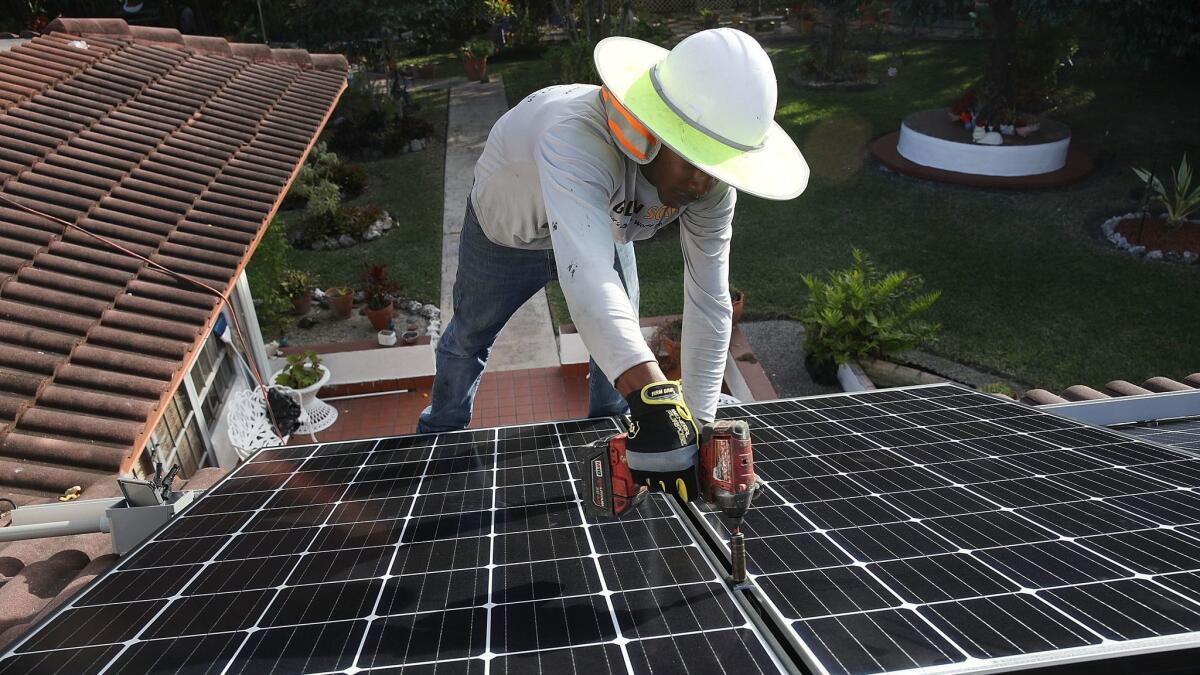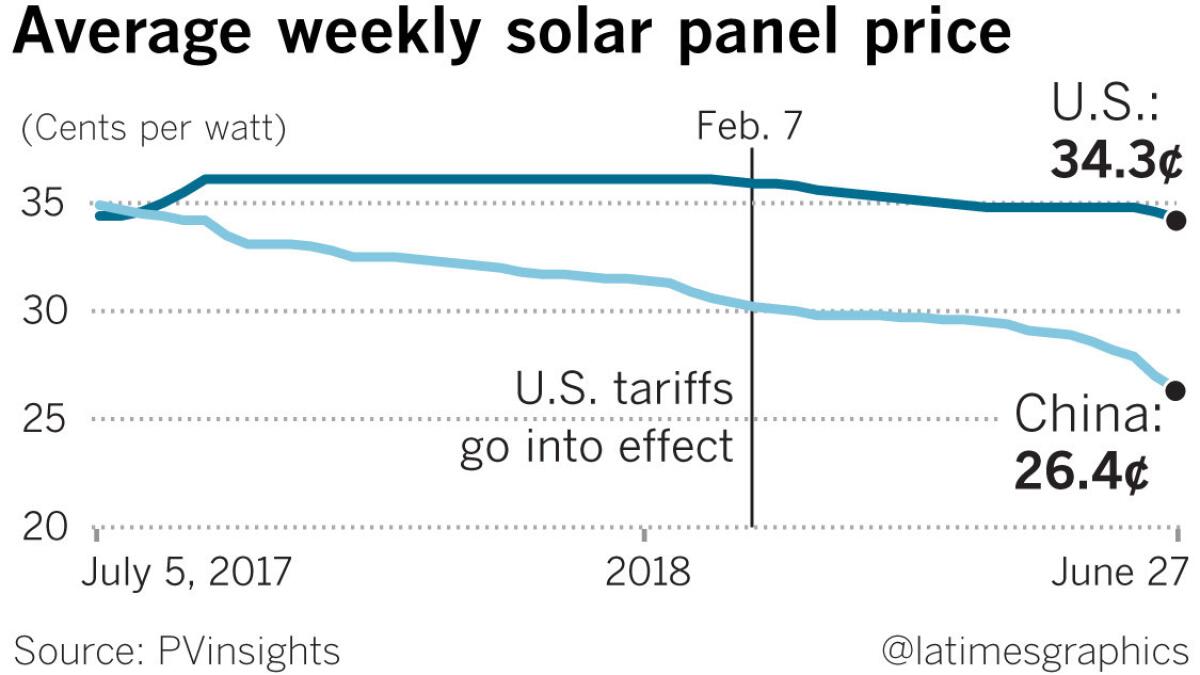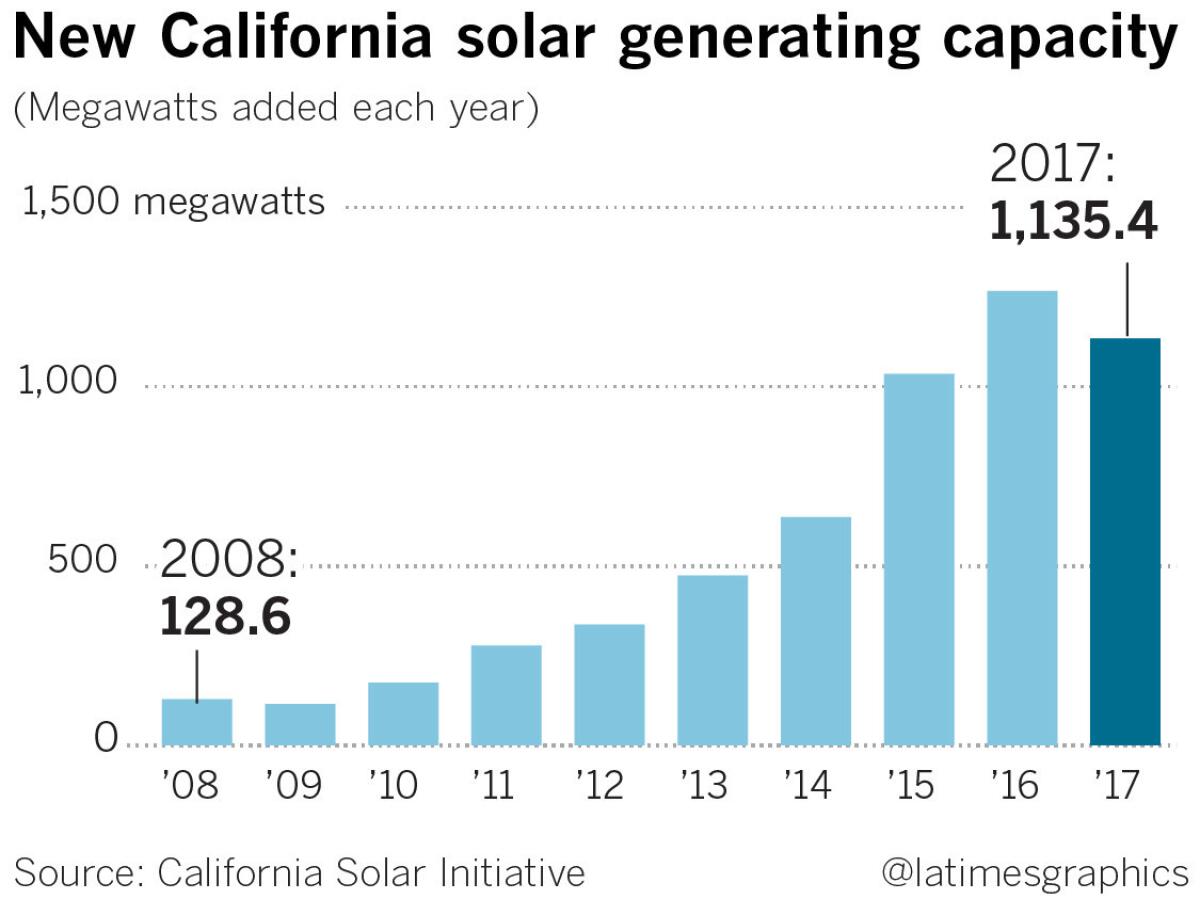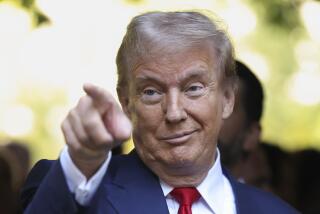The roiled solar power market shows how Trump’s tariffs can disrupt an industry

A 30% U.S. tariff on imported solar panels put in place last winter should have caused prices here to jump.
But when tariffs are unleashed, as businesses are learning, things don’t always go as expected.
For the record:
11:05 a.m. July 7, 2018An earlier version of this article said there were about 613,000 megawatts worth of solar panels imported to the U.S. on average per month in the first half of the year. The figure is 613 megawatts.
Therein lies a cautionary tale of the uncertainty in store for other industries as the Trump administration’s latest tariffs took effect Friday against hundreds of Chinese imports valued at $34 billion, including semiconductors, farm machinery, medical devices and aircraft parts.
China immediately retaliated against U.S. shipments of farm produce, dairy products and automobiles.
Prices on solar panels did rise last summer as the Trump administration publicly considered the tariffs, mostly on imports from China and other Asian countries. That caused U.S. companies to scramble to purchase as many foreign panels as they could to beat the looming duties.
The higher prices led two U.S. manufacturers to say they’d boost production. At least three foreign manufacturers have made plans to open American factories.
But then, on May 31, China surprisingly slashed its solar subsidies and incentives. The sudden reduction in demand led to a global oversupply of solar panels that further fueled the price drop that began after the tariffs took effect in February.

The upshot: Prices in the United States now are back where they were last summer and worldwide prices could tumble as much as 35% this year, analysts say.
“We’re still really reeling from the impact,” Bernadette Del Chiaro, executive director of the California Solar & Storage Assn., said of the tariffs. “Almost 50% of the roiling and disruption comes from just the unknown and the uncertainty.”
The experience over the last year with the U.S. solar tariffs shows that the straightforward goal of boosting domestic manufacturing often conflicts with the real-world flow of goods. Once you launch a trade war, it’s very hard to control the consequences.
That was on full display recently when Harley-Davidson Inc., said it would move some production abroad to avoid tariffs that the European Union slapped on U.S. motorcycles. Those levies were in response to Trump administration tariffs on imported steel and aluminum that were designed to boost American manufacturing.
Solar industry executives and workers are feeling whipsawed as they also deal with the fallout from the tariffs on steel and aluminum, materials that are used in the racks that hold solar panels on rooftops and on large solar farms.
“There’s no question it’s had an impact on the size of the American solar market,” said Tom Werner, chief executive of SunPower Corp., a San Jose-based company that makes and installs solar panels.
California had about 86,000 people working in the solar industry last year, by far the most of any state, though that number is down about 14% from 2016, according to data from the Solar Foundation, a nonprofit group that promotes solar power.
New solar power generating capacity declined last year in California for the first time since 2009, according to state figures. And Bloomberg New Energy Finance, which uses proprietary data to analyze industry trends, recently estimated the global solar market could shrink this year for the first time ever.

“There’s just a lot of demand that could have happened that is not going to ultimately be realized because of these tariffs,” said Cory Honeyman, associate director of the U.S. solar research practice at GTM Research, a market analysis and advisory firm. The tariffs led the firm to reduce its forecast for additional U.S. solar generating capacity during 2018-2022 by 11%.
The tariffs and overall trade tensions almost certainly were factors in the decision by China’s leaders to cut its state support for solar energy development.
China had been furiously pumping money into green energy projects, accounting for nearly half of the $280 billion invested in renewable energy projects in 2017, according to Bloomberg New Energy Finance. China added 50 gigawatts of solar power last year, accounting for more than half of all global solar photovoltaic module installations. The country now has a kilometer-long highway paved with solar panels, the world’s largest floating solar farm, and panels atop countless roofs in villages and cities.
“Even a pig will fly if it’s hit by a tornado,” said Liu Shisheng, 25, using a Chinese expression to describe how his fledgling 20-employee business in central-eastern Wenzhou had soared by installing solar panels at homes and businesses.
Last month, the pig fell with a thump back to Earth. Liu, a draftsman, said the company closed just days after the government’s new policy.
“We actually had a lot of ongoing projects, they all stopped,” Liu said from the northeastern city of Harbin, where he has returned home to look for a new job.
The pain of layoffs, bankruptcies and consolidation in the Chinese industry is seen as a necessary correction after years of sometimes wasteful, deficit-financed overbuilding of solar generation and panel production facilities.
Beijing’s new policy is expected to reduce solar generation in China this year by about 30% from what was previously expected. Because China dominates the world’s solar market, a glut of manufacturing capacity already has started to drive down prices for solar panels.
The upshot is that U.S. producers may not need to add as much manufacturing as they had anticipated in the wake of the tariffs before the China policy change, said Edurne Zoco, head of solar research at IHS Markit, a business research and analysis firm.
In April 2017, bankrupt Georgia solar panel manufacturer Suniva Inc. formally asked the U.S. International Trade Commission to impose tariffs on inexpensive imported panels that the company said had crushed its business. The petition was later joined by SolarWorld Americas Inc., an Oregon company, after its German parent — a leading European solar panel manufacturer — also sought bankruptcy protection.
A commission investigation found that the mostly Chinese-made panels, which fueled the solar boom in the United States, were priced artificially low and had severely reduced American solar-panel manufacturing. It recommended that the United States impose tariffs. Trump agreed, and in January, the administration announced hefty levies: 30% the first year, declining gradually to 15% when they end after the fourth year. They took effect Feb. 7.
The tariffs were opposed by most of the U.S. solar industry, on the likelihood that its costs would rise. However, Edward Harner, chief operating officer of North Hollywood-based Green Solar Technologies, testified to the commission in favor of the tariffs.
“We just thought it would be a good thing for American manufacturing and also we questioned the quality of panels coming from many different countries,” Harner said in an interview. The company touts that it uses only U.S.-made panels when it installs solar power systems on homes and businesses, a message he said resonates with many customers, particularly in the Midwest.
“This little tariff increase has not significantly affected our business and I doubt other companies’ business,” Harner said. But he acknowledged that part of the reason was that some U.S. companies stockpiled imported panels before the tariffs were put in place.
About 613 megawatts worth of solar panels were imported on average per month over the first half of last year, according to the U.S. Energy Information Administration. That jumped about 75% to nearly 1.1 gigawatts a month for the last six months of 2017 as the International Trade Commission considered and then ruled on the tariff case.
“The distributors, starting last summer, just started stockpiling modules,” Del Chiaro said. “They converted whole parking lots into storage with shipping containers. It was a way to have an inventory to kind of try to protect their customers, the installers.”
The demand for solar panels caused prices in the United States to increase ahead of the actual imposition of the tariffs. But with the stockpile in place, prices here began falling once the tariffs kicked in.
“Pricing over the course of 2018 is expected to fall, despite the introduction of tariffs,” Honeyman said.
Some solar companies weren’t large enough to stockpile solar panels or didn’t want to take the risk. Now they’re feeling the pain.
“It’s just so hard to tell which way the costs were going to go on those panels,” said Scott Canada, senior vice president of solar and renewable energy for McCarthy Building Companies, an Arizona firm that does large-scale solar installations. “We’re a construction company. We have thin margins. A major move in panel prices would have put us in a really bad spot.”
After what he called a “banner” 2016 for its work building large-scale solar generating facilities for utility customers, McCarthy Building Companies saw business tail off in 2017 as some clients decided to put projects on hold, he said. That led the company to cut by roughly half the number of people it employs for solar installations, to about 1,000.
Large-scale solar power projects have been hit hard by the tariffs because the cost of panels plays a much bigger role in the overall price than it does for smaller residential and commercial rooftop installations.
Pine Gate Renewables, a solar project developer in North Carolina, also wasn’t large enough to stockpile solar panels, Chief Executive Zoe Hanes said. The company will complete only about half of the 400 megawatts worth of solar projects it had planned to finish this year. Because of that, Pine Gate Renewables didn’t hire the additional 30 people it had planned to add to its 85-person workforce this year.
“That uncertainty has created so many challenges,” Hanes said.
The Solar Energy Industries Assn., a nationwide trade group, had estimated the tariffs would cost 23,000 jobs in the United States in their first year — a combination of layoffs and positions that weren’t added to an industry that employs about 250,000 people. So far, it’s tallied about 8,000 jobs since the tariffs took effect, said spokesman Dan Whitten.
Like about 50 other companies, SunPower has applied to U.S. officials for an exemption from the solar tariffs. The company argues that the type of solar panels it makes at its overseas factories aren’t available from U.S. manufacturers.
The company took another step to mitigate the impact of the tariffs — it struck a deal in April to buy SolarWorld Americas, which has more U.S. manufacturing capability. The deal would not have been made if not for the tariffs, Werner said.
“It’s clear that this administration wants American manufacturing,” he said of the purchase, which has not yet closed. “We wanted to make an unequivocal super-clear move.”
SunPower plans to ramp up SolarWorld’s production capabilities, Werner said. But it can’t make that kind of investment while it’s spending between $1.5 million and $2 million a week on solar tariffs.
“Our investment in America has been curtailed because we have to pay tariffs instead of investing,” he said. “We would have added hundreds of jobs that we’re not going to add until we find out what happens with our exclusion request.”
The U.S. trade representative’s office has been overwhelmed with requests for exemptions, not just on solar panels but steel and aluminum as well. It’s not known when the agency will make those decisions.
For China’s solar industry, a downsizing and restructuring were a long time coming, experts said. But experts said the trade conflict with the United States only added to Beijing’s urgency to protect its renewable energy industry.
“Those companies that fail because of the policy change should become bankrupt,” said Xu Qinhua, director of the Center for International Energy and Environment Strategy Studies at Renmin University of China. Chinese solar firm stocks have been pounded in recent weeks.
Yingli Green Energy, once the largest solar module maker but long troubled by heavy debts, was delisted last month by the New York Stock Exchange.
Other Chinese producers, such as Shanghai-based JinkoSolar, which is opening a module plant in the United States, said they would be fine as their sales come mostly from overseas markets. The company is counting on orders from places such as India and Spain, where installations are set to rise this year.
Puzzanghera reported from Washington and Lee reported from Shanghai.
[email protected] | Twitter: @JimPuzzanghera
[email protected] | Twitter: @dleelatimes
More to Read
Inside the business of entertainment
The Wide Shot brings you news, analysis and insights on everything from streaming wars to production — and what it all means for the future.
You may occasionally receive promotional content from the Los Angeles Times.












